A Comparative Study of Active Rock Glaciers Mapped from Geomorphic- and Kinematic-Based Approaches in Daxue Shan, Southeast Tibetan Plateau
Abstract
:1. Introduction
2. Study Area
2.1. Geological Overview
2.2. Geomorphic-Based Rock Glacier Inventory in Daxue Shan
3. Remote Sensing Data and Data Processing
3.1. Detecting Surface Deformation with Multi-Temporal InSAR
3.2. Rock Glacier Mapping
3.3. Comparison with the Existing Rock Glacier Inventory
4. Result
4.1. ARGs from the InSAR-Assist Kinematic-Based Inventorying
4.2. Comparisons of ARG Distributions and Outlines in KBI and GBI
4.3. Comparative Analysis of the Geomorphic Parameters in GBI and KBI
4.3.1. Area, Length, and Slope Angle
4.3.2. ILP and FLP Altitudes
4.3.3. Aspect Angle
4.4. Active Rock Glacier Velocities
5. Discussion
5.1. The Geomorphic-Based and Kinematic-Based ARG Inventory Approaches
5.2. Influences of SAR Image Selection on ARG Inventory
5.2.1. Active Rock Glacier Inventory from a Single SAR Image Pair
5.2.2. Influence of SAR Acquisition Season on ARG Inventories
5.3. Implication for Rock Glacier-Based Permafrost Distribution Estimation
5.4. Implications for Water Storage Content Estimation
6. Conclusions
Author Contributions
Funding
Institutional Review Board Statement
Informed Consent Statement
Data Availability Statement
Acknowledgments
Conflicts of Interest
References
- Capps, S.R., Jr. Rock glaciers in Alaska. J. Geol. 1910, 18, 359–375. [Google Scholar] [CrossRef]
- Ostrem, G. Rock glaciers and ice-cored moraines, a reply to D. Barsch. Geogr. Ann. Ser. A Phys. Geogr. 1971, 53, 207–213. [Google Scholar] [CrossRef]
- Barsch, D. Active rock glaciers as indicators for discontinuous alpine permafrost. An example from the Swiss Alps. In Proceedings of the International Conference on Permafrost, Edmonton, AB, Canada, 10–13 July 1978. [Google Scholar]
- Brardinoni, F.; Scotti, R.; Sailer, R.; Mair, V. Evaluating sources of uncertainty and variability in rock glacier inventories. Earth Surf. Process. Landf. 2019, 44, 2450–2466. [Google Scholar] [CrossRef]
- Azócar, G.F.; Brenning, A. Hydrological and geomorphological significance of rock glaciers in the dry Andes, Chile (27°–33° S). Permafr. Periglac. Process. 2010, 21, 42–53. [Google Scholar] [CrossRef]
- Jones, D.B.; Harrison, S.; Anderson, K.; Whalley, W.B. Rock glaciers and mountain hydrology: A review. Earth Sci. Rev. 2019, 193, 66–90. [Google Scholar] [CrossRef]
- Brenning, A. Geomorphological, hydrological and climatic significance of rock glaciers in the Andes of Central Chile (33–35° S). Permafr. Periglac. Process. 2005, 16, 231–240. [Google Scholar] [CrossRef]
- Knight, J.; Harrison, S.; Jones, D.B. Rock glaciers and the geomorphological evolution of deglacierizing mountains. Geomorphology 2019, 324, 14–24. [Google Scholar] [CrossRef]
- Delaloye, R.; Barboux, C.; Bodin, X.; Brenning, A.; Hartl, L.; Hu, Y.; Ikeda, A.; Kaufmann, V.; Kellerer-Pirklbauer, A.; Lambiel, C. Rock glacier inventories and kinematics: A new IPA Action Group. In Proceedings of the 5th European Conference on Permafrost, Chamonix-Mont Blanc, France, 23 June–1 July 2018; pp. 392–393. [Google Scholar]
- Hu, Y.; Liu, L.; Wang, X.; Zhao, L.; Wu, T.; Cai, J.; Zhu, X.; Hao, J. Quantification of permafrost creep provides kinematic evidence for classifying a puzzling periglacial landform. Earth Surf. Process. Landf. 2020, 46, 465–477. [Google Scholar] [CrossRef]
- Marcer, M.; Serrano, C.; Brenning, A.; Bodin, X.; Goetz, J.; Schoeneich, P. Evaluating the destabilization susceptibility of active rock glaciers in the French Alps. Cryosphere 2019, 13, 141–155. [Google Scholar] [CrossRef] [Green Version]
- Cicoira, A.; Beutel, J.; Faillettaz, J.; Gärtner-Roer, I.; Vieli, A. Resolving the influence of temperature forcing through heat conduction on rock glacier dynamics: A numerical modelling approach. Cryosphere 2019, 13, 927–942. [Google Scholar] [CrossRef] [Green Version]
- Onaca, A.; Ardelean, F.; Urdea, P.; Magori, B. Southern Carpathian rock glaciers: Inventory, distribution and environmental controlling factors. Geomorphology 2017, 293, 391–404. [Google Scholar] [CrossRef]
- Onaca, A.L.; Urdea, P.; Ardelean, A.C. Internal structure and permafrost characteristics of the rock glaciers of southern carpathians (Romania) assessed by geoelectrical soundings and thermal monitoring. Geogr. Ann. Ser. A Phys. Geogr. 2016, 95, 249–266. [Google Scholar] [CrossRef]
- Berthling, I. Beyond confusion: Rock glaciers as cryo-conditioned landforms. Geomorphology 2011, 131, 98–106. [Google Scholar] [CrossRef]
- Cao, B.; Li, X.; Feng, M.; Zheng, D. Quantifying Overestimated Permafrost Extent Driven by Rock Glacier Inventory. Geophys. Res. Lett. 2021, 48, e2021GL092476. [Google Scholar] [CrossRef]
- Janke, J.R.; Ng, S.; Bellisario, A. An inventory and estimate of water stored in firn fields, glaciers, debris-covered glaciers, and rock glaciers in the Aconcagua River Basin, Chile. Geomorphology 2017, 296, 142–152. [Google Scholar] [CrossRef]
- Esper Angillieri, M.Y. A preliminary inventory of rock glaciers at 30° S latitude, Cordillera Frontal of San Juan, Argentina. Quat. Int. 2009, 195, 151–157. [Google Scholar] [CrossRef]
- Brenning, A.; Long, S.; Fieguth, P. Detecting rock glacier flow structures using Gabor filters and IKONOS imagery. Remote Sens. Environ. 2012, 125, 227–237. [Google Scholar] [CrossRef]
- Scotti, R.; Brardinoni, F.; Alberti, S.; Frattini, P.; Crosta, G.B. A regional inventory of rock glaciers and protalus ramparts in the central Italian Alps. Geomorphology 2013, 186, 136–149. [Google Scholar] [CrossRef]
- Schmid, M.O.; Baral, P.; Gruber, S.; Shahi, S.; Shrestha, T.; Stumm, D.; Wester, P. Assessment of permafrost distribution maps in the Hindu Kush Himalayan region using rock glaciers mapped in Google Earth. Cryosphere 2015, 9, 2089–2099. [Google Scholar] [CrossRef] [Green Version]
- Ran, Z.; Liu, G. Rock glaciers in Daxue Shan, south-eastern Tibetan Plateau: An inventory, their distribution, and their environmental controls. Cryosphere 2018, 12, 2327–2340. [Google Scholar] [CrossRef] [Green Version]
- Marcer, M. Rock glaciers automatic mapping using optical imagery and convolutional neural networks. Permafr. Periglac. Process. 2020, 31, 561–566. [Google Scholar] [CrossRef]
- Brenning, A. Benchmarking classifiers to optimally integrate terrain analysis and multispectral remote sensing in automatic rock glacier detection. Remote Sens. Environ. 2009, 113, 239–247. [Google Scholar] [CrossRef]
- Robson, B.A.; Bolch, T.; MacDonell, S.; Hölbling, D.; Rastner, P.; Schaffer, N. Automated detection of rock glaciers using deep learning and object-based image analysis. Remote Sens. Environ. 2020, 250, 112033. [Google Scholar] [CrossRef]
- Kääb, A.; Strozzi, T.; Bolch, T.; Caduff, R.; Trefall, H.; Stoffel, M.; Kokarev, A. Inventory, motion and acceleration of rock glaciers in Ile Alatau and Kungöy Ala-Too, northern Tien Shan, since the 1950s. Cryosphere Discuss. 2020, 2020, 1–37. [Google Scholar] [CrossRef]
- Ulrich, V.; Williams, J.G.; Zahs, V.; Anders, K.; Hecht, S.; Höfle, B. Measurement of rock glacier surface change over different timescales using terrestrial laser scanning point clouds. Earth Surf. Dyn. 2021, 9, 19–28. [Google Scholar] [CrossRef]
- Massonnet, D.; Feigl, K.L. Radar interferometry and its application to changes in the Earth’s surface. Rev. Geophys. 1998, 36, 441–500. [Google Scholar] [CrossRef] [Green Version]
- Nagler, T.; Mayer, C.; Rott, H. Feasibility of DINSAR for mapping complex motion fields of Alpine ice-and rock-glaciers. In Proceedings of the Third International Symposium on Retrieval of Bio-and Geo-Physical Parameters from SAR Data for Land Applications, Sheffield, UK, 11–14 September 2002; pp. 377–382. [Google Scholar]
- Lilleøren, K.S.; Etzelmüller, B.; Gärtner-Roer, I.; Kääb, A.; Westermann, S.; Gudmundsson, A. The Distribution, Thermal Characteristics and Dynamics of Permafrost in Tröllaskagi, Northern Iceland, as Inferred from the Distribution of Rock Glaciers and Ice-Cored Moraines. Permafr. Periglac. Process. 2013, 24, 322–335. [Google Scholar] [CrossRef]
- Liu, L.; Millar, C.I.; Westfall, R.D.; Zebker, H.A. Surface motion of active rock glaciers in the Sierra Nevada, California, USA: Inventory and a case study using InSAR. Cryosphere 2013, 7, 1109–1119. [Google Scholar] [CrossRef] [Green Version]
- Barboux, C.; Delaloye, R.; Lambiel, C. Inventorying slope movements in an Alpine environment using DInSAR. Earth Surf. Process. Landf. 2014, 39, 2087–2099. [Google Scholar] [CrossRef] [Green Version]
- Necsoiu, M.; Onaca, A.; Wigginton, S.; Urdea, P. Rock glacier dynamics in Southern Carpathian Mountains from high-resolution optical and multi-temporal SAR satellite imagery. Remote Sens. Environ. 2016, 177, 21–36. [Google Scholar] [CrossRef] [Green Version]
- Wang, X.; Liu, L.; Zhao, L.; Wu, T.; Li, Z.; Liu, G. Mapping and inventorying active rock glaciers in the northern Tien Shan of China using satellite SAR interferometry. Cryosphere 2017, 11, 997–1014. [Google Scholar] [CrossRef] [Green Version]
- Strozzi, T.; Caduff, R.; Jones, N.; Barboux, C.; Delaloye, R.; Bodin, X.; Kääb, A.; Mätzler, E.; Schrott, L. Monitoring Rock Glacier Kinematics with Satellite Synthetic Aperture Radar. Remote Sens. 2020, 12, 559. [Google Scholar] [CrossRef] [Green Version]
- Brencher, G.; Handwerger, A.L.; Munroe, J.S. InSAR-based characterization of rock glacier movement in the Uinta Mountains, Utah, USA. Cryosphere 2021, 15, 4823–4844. [Google Scholar] [CrossRef]
- Reinosch, E.; Gerke, M.; Riedel, B.; Schwalb, A.; Ye, Q.; Buckel, J. Rock glacier inventory of the western Nyainqêntanglha Range, Tibetan Plateau, supported by InSAR time series and automated classification. Permafr. Periglac. Process. 2021, 32, 657–672. [Google Scholar] [CrossRef]
- Zou, D.; Zhao, L.; Sheng, Y.; Chen, J.; Hu, G.; Wu, T.; Wu, J.; Xie, C.; Wu, X.; Pang, Q.; et al. A new map of permafrost distribution on the Tibetan Plateau. Cryosphere 2017, 11, 2527–2542. [Google Scholar] [CrossRef] [Green Version]
- Zhang, P.-Z. A review on active tectonics and deep crustal processes of the Western Sichuan region, eastern margin of the Tibetan Plateau. Tectonophysics 2013, 584, 7–22. [Google Scholar] [CrossRef]
- Ferretti, A.; Fumagalli, A.; Novali, F.; Prati, C.; Rocca, F.; Rucci, A. A New Algorithm for Processing Interferometric Data-Stacks: SqueeSAR. IEEE Trans. Geosci. Remote Sens. 2011, 49, 3460–3470. [Google Scholar] [CrossRef]
- Wegnüller, U.; Werner, C.; Strozzi, T.; Wiesmann, A.; Frey, O.; Santoro, M. Sentinel-1 Support in the GAMMA Software. Procedia Comput. Sci. 2016, 100, 1305–1312. [Google Scholar] [CrossRef] [Green Version]
- Tadono, T.; Nagai, H.; Ishida, H.; Oda, F.; Naito, S.; Minakawa, K.; Iwamoto, H. Generation of the 30 M-Mesh Global Digital Surface Model by Alos Prism. ISPRS Int. Arch. Photogramm. Remote Sens. Spat. Inf. Sci. 2016, XLI-B4, 157–162. [Google Scholar] [CrossRef] [Green Version]
- Yunjun, Z.; Fattahi, H.; Amelung, F. Small baseline InSAR time series analysis: Unwrapping error correction and noise reduction. Comput. Geosci. 2019, 133, 104331. [Google Scholar] [CrossRef] [Green Version]
- Jolivet, R.; Grandin, R.; Lasserre, C.; Doin, M.P.; Peltzer, G. Systematic InSAR tropospheric phase delay corrections from global meteorological reanalysis data. Geophys. Res. Lett. 2011, 38. [Google Scholar] [CrossRef] [Green Version]
- Rangecroft, S.; Harrison, S.; Anderson, K.; Magrath, J.; Castel, A.P.; Pacheco, P. A First Rock Glacier Inventory for the Bolivian Andes. Permafr. Periglac. Process. 2014, 25, 333–343. [Google Scholar] [CrossRef]
- Roer, I.; Nyenhuis, M. Rockglacier activity studies on a regional scale: Comparison of geomorphological mapping and photogrammetric monitoring. Earth Surf. Process. Landf. 2007, 32, 1747–1758. [Google Scholar] [CrossRef]
- Rouet-Leduc, B.; Jolivet, R.; Dalaison, M.; Johnson, P.A.; Hulbert, C. Autonomous extraction of millimeter-scale deformation in InSAR time series using deep learning. Nat. Commun. 2021, 12, 6480. [Google Scholar] [CrossRef]
- Villarroel, C.; Tamburini Beliveau, G.; Forte, A.; Monserrat, O.; Morvillo, M. DInSAR for a Regional Inventory of Active Rock Glaciers in the Dry Andes Mountains of Argentina and Chile with Sentinel-1 Data. Remote Sens. 2018, 10, 1588. [Google Scholar] [CrossRef] [Green Version]
- Torres, R.; Snoeij, P.; Geudtner, D.; Bibby, D.; Davidson, M.; Attema, E.; Potin, P.; Rommen, B.; Floury, N.; Brown, M. GMES Sentinel-1 mission. Remote Sens. Environ. 2012, 120, 9–24. [Google Scholar] [CrossRef]
- Rouyet, L.; Lauknes, T.R.; Christiansen, H.H.; Strand, S.M.; Larsen, Y. Seasonal dynamics of a permafrost landscape, Adventdalen, Svalbard, investigated by InSAR. Remote Sens. Environ. 2019, 231, 111236. [Google Scholar] [CrossRef]
- Sattler, K.; Anderson, B.; Mackintosh, A.; Norton, K.; de Róiste, M. Estimating Permafrost Distribution in the Maritime Southern Alps, New Zealand, Based on Climatic Conditions at Rock Glacier Sites. Front. Earth Sci. 2016, 4, 4. [Google Scholar] [CrossRef] [Green Version]
- Azócar, G.F.; Brenning, A.; Bodin, X. Permafrost distribution modelling in the semi-arid Chilean Andes. Cryosphere 2017, 11, 877–890. [Google Scholar] [CrossRef] [Green Version]
- Hassan, J.; Chen, X.; Muhammad, S.; Bazai, N.A. Rock glacier inventory, permafrost probability distribution modeling and associated hazards in the Hunza River Basin, Western Karakoram, Pakistan. Sci. Total Environ. 2021, 782, 146833. [Google Scholar] [CrossRef] [PubMed]
- Haq, M.A.; Baral, P. Study of permafrost distribution in Sikkim Himalayas using Sentinel-2 satellite images and logistic regression modelling. Geomorphology 2019, 333, 123–136. [Google Scholar] [CrossRef]
- Gruber, S. Derivation and analysis of a high-resolution estimate of global permafrost zonation. Cryosphere 2012, 6, 221–233. [Google Scholar] [CrossRef] [Green Version]
- Obu, J.; Westermann, S.; Bartsch, A.; Berdnikov, N.; Christiansen, H.H.; Dashtseren, A.; Delaloye, R.; Elberling, B.; Etzelmüller, B.; Kholodov, A.; et al. Northern Hemisphere permafrost map based on TTOP modelling for 2000–2016 at 1 km2 scale. Earth Sci. Rev. 2019, 193, 299–316. [Google Scholar] [CrossRef]
- Smith, M.; Riseborough, D. Permafrost monitoring and detection of climate change. Permafr. Periglac. Process. 1996, 7, 301–309. [Google Scholar] [CrossRef]
- Harrington, J.S.; Hayashi, M. Application of distributed temperature sensing for mountain permafrost mapping. Permafr. Periglac. Process. 2019, 30, 113–120. [Google Scholar] [CrossRef]
- Gubler, S.; Fiddes, J.; Keller, M.; Gruber, S. Scale-dependent measurement and analysis of ground surface temperature variability in alpine terrain. Cryosphere 2011, 5, 431–443. [Google Scholar] [CrossRef] [Green Version]
- Jones, D.B.; Harrison, S.; Anderson, K.; Selley, H.L.; Wood, J.L.; Betts, R.A. The distribution and hydrological significance of rock glaciers in the Nepalese Himalaya. Glob. Planet. Chang. 2018, 160, 123–142. [Google Scholar] [CrossRef] [Green Version]
- Hu, Y.; Harrison, S.; Liu, L.; Wood, J.L. Modelling rock glacier velocity and ice content, Khumbu and Lhotse Valleys, Nepal. Cryosphere Discuss. 2021, 2021, 1–34. [Google Scholar] [CrossRef]
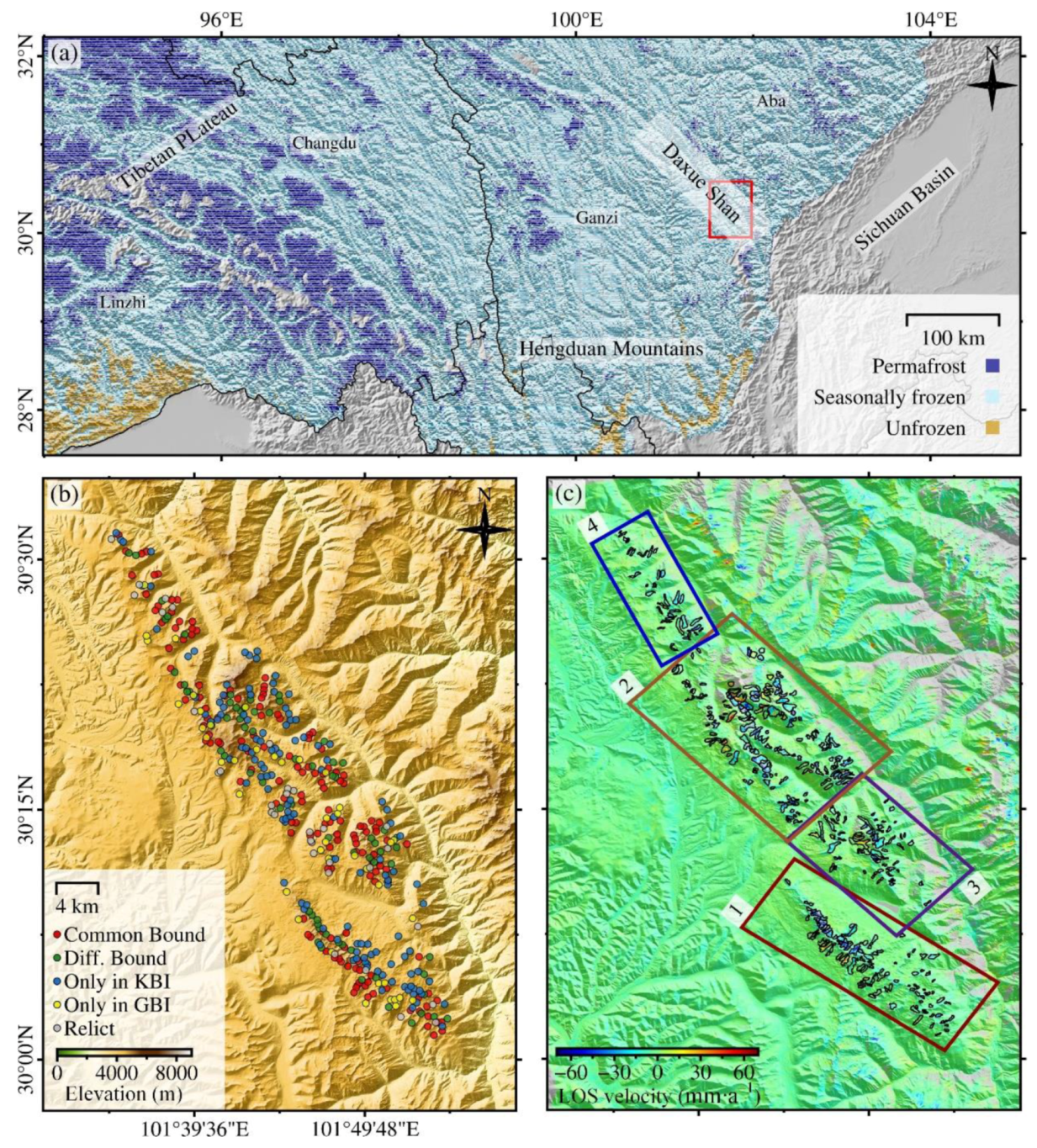
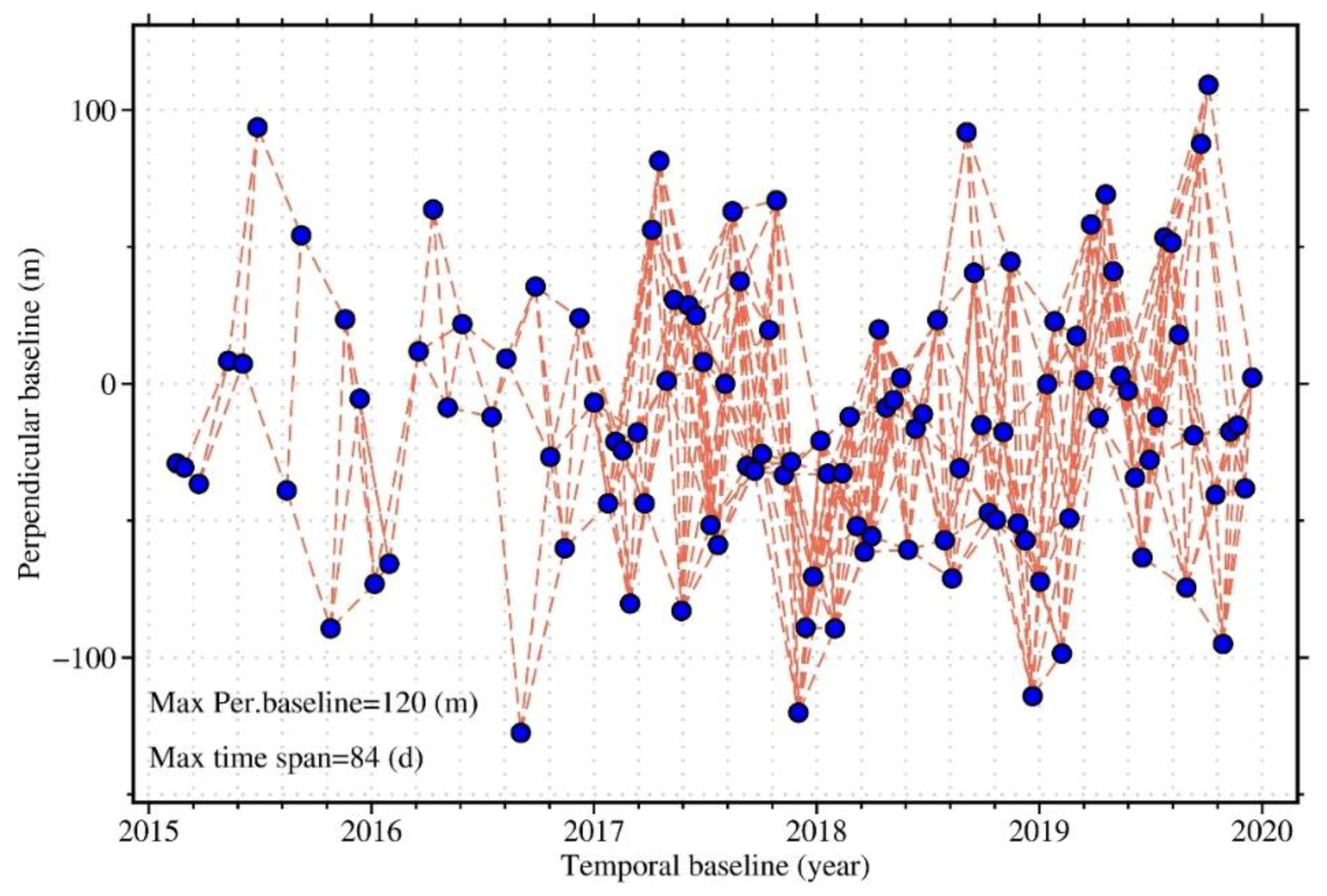
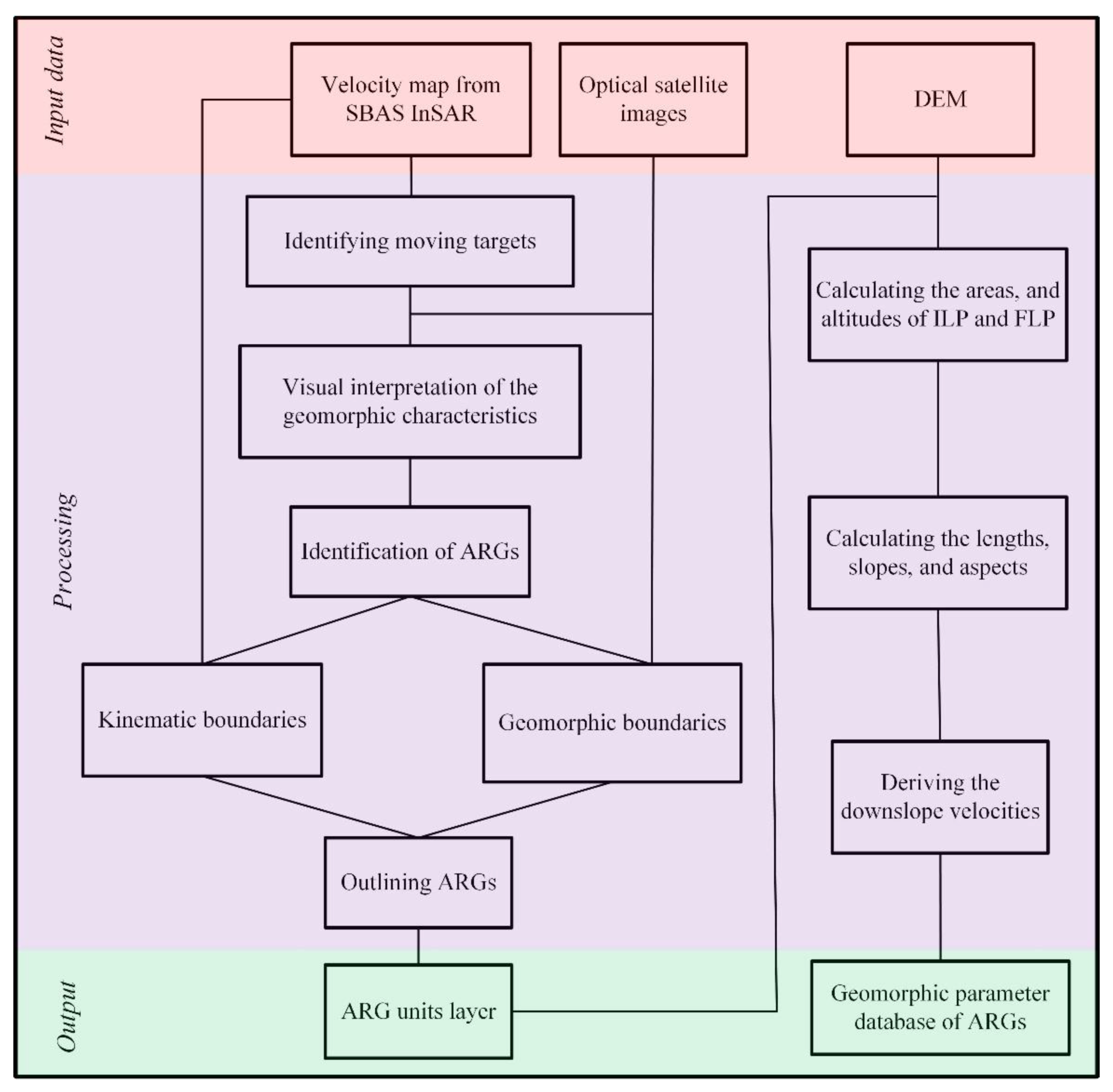

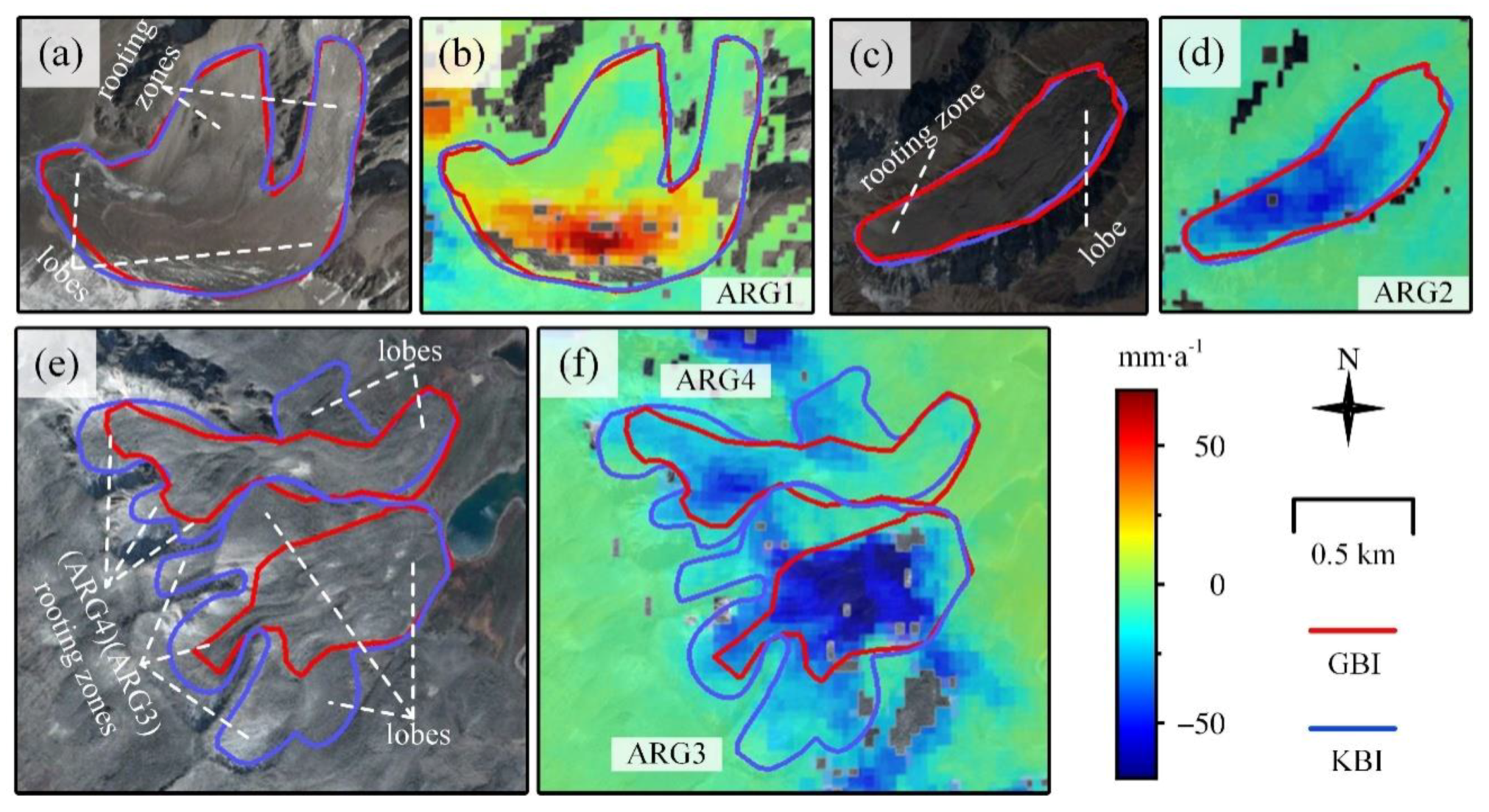
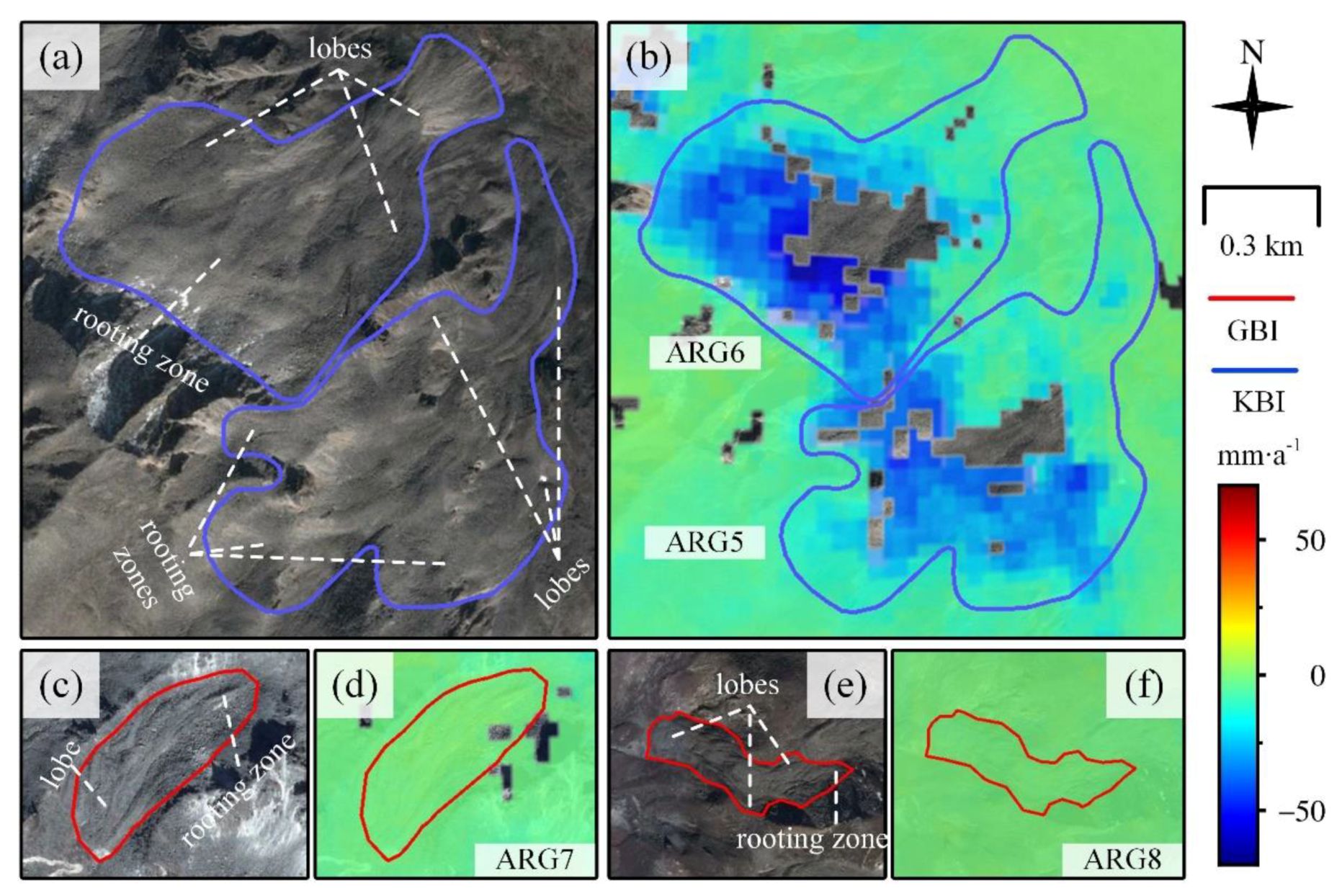




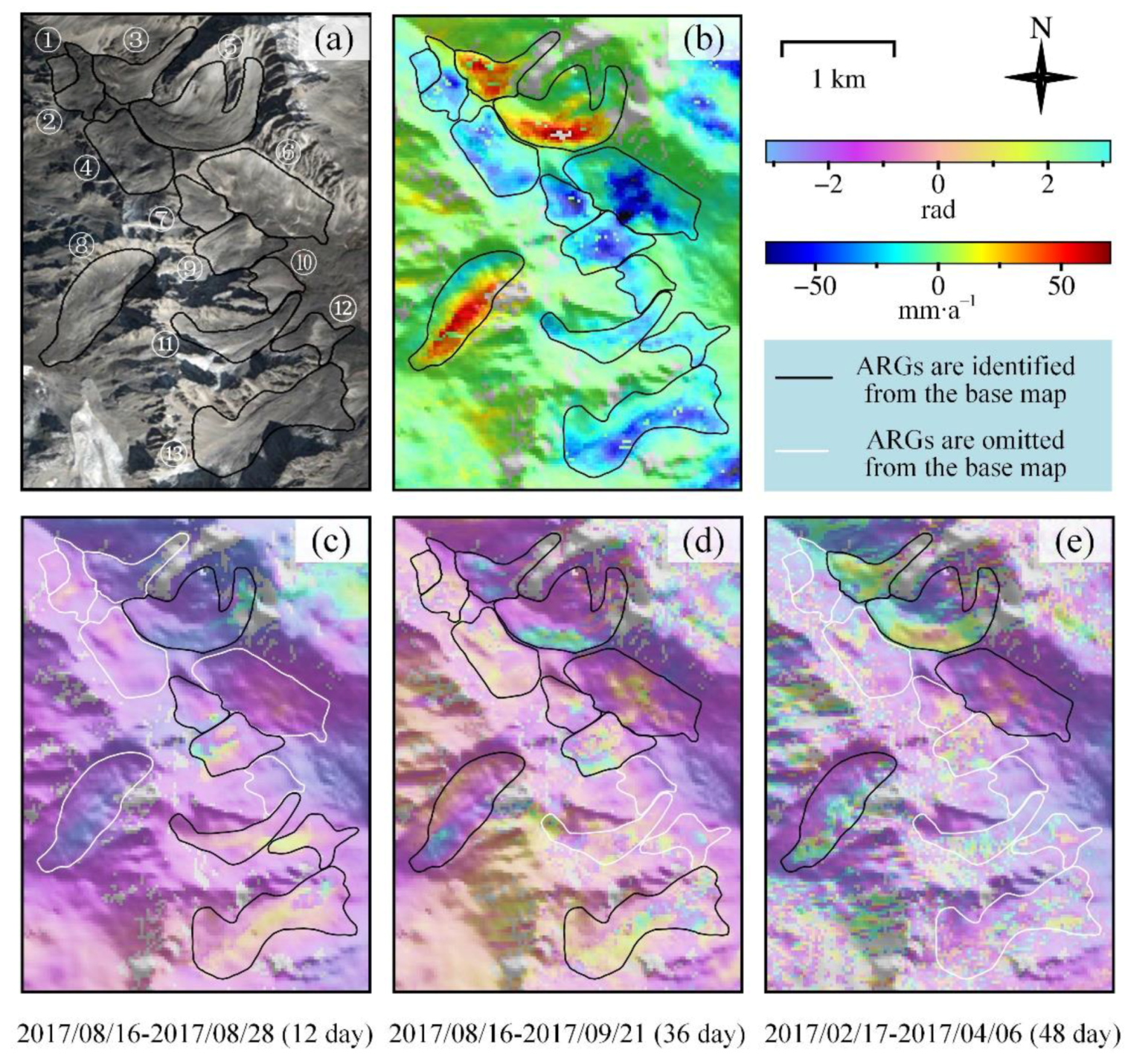

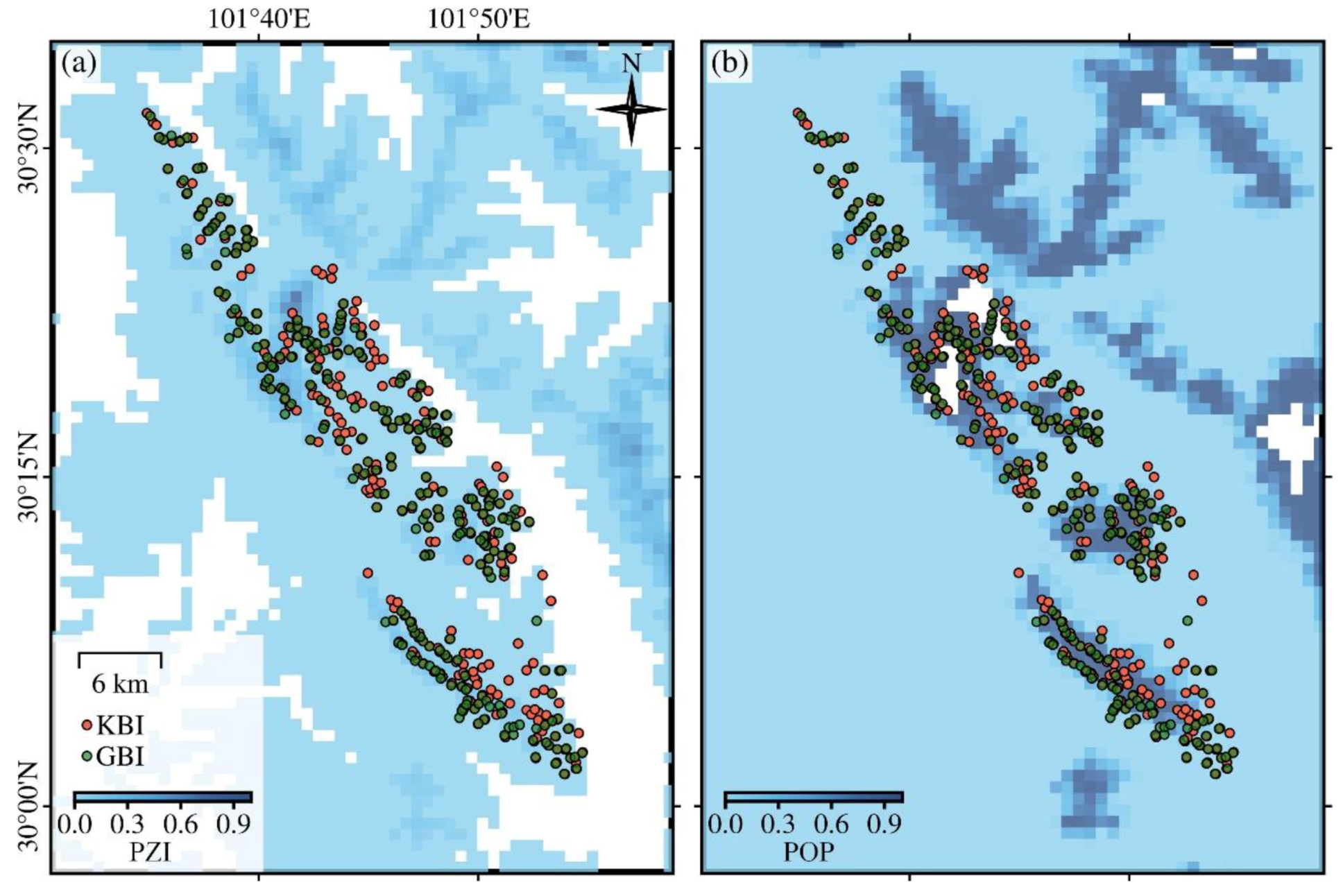
| Type | Nu | Area (km2) | Length (m) | Slope (°) | ILP Altitude (m) | FLP Altitude (m) | Total Area (km2) | |||||
|---|---|---|---|---|---|---|---|---|---|---|---|---|
| Mean | Min | Mean | Min | Mean | Min | Mean | Min | Mean | Min | |||
| Max | Max | Max | Max | Max | ||||||||
| K-Moraine | 180 | 0.21 | 0.02 | 792 | 195 | 19.4 | 7.4 | 4628 | 4289 | 4376 | 3914 | 38.7 |
| 0.81 | 2692 | 34.2 | 5057 | 4760 | ||||||||
| G-Moraine | 132 | 0.2 | 0.02 | 839 | 165 | 16.3 | 8.1 | 4612 | 4298 | 4379 | 3835 | 26.9 |
| 0.78 | 2711 | 30.4 | 4984 | 4771 | ||||||||
| K-Talus | 164 | 0.17 | 0.02 | 682 | 150 | 19.2 | 8.8 | 4544 | 4135 | 4332 | 3860 | 27.9 |
| 0.92 | 2158 | 34 | 5094 | 4809 | ||||||||
| G-Talus | 119 | 0.2 | 0.031 | 840 | 170 | 16.6 | 7.3 | 4573 | 4188 | 4334 | 3823 | 23.8 |
| 1.012 | 2156 | 27.8 | 5095 | 4809 | ||||||||
| K-All | 344 | 0.19 | 0.02 | 736 | 150 | 19.3 | 7.4 | 4588 | 4135 | 4355 | 3860 | 66.6 |
| 0.92 | 2692 | 34.2 | 5094 | 4809 | ||||||||
| G-All | 251 | 0.2 | 0.02 | 839 | 165 | 16.4 | 7.3 | 4593 | 4188 | 4357 | 3823 | 50.6 |
| 1.012 | 2711 | 30.4 | 5095 | 4809 | ||||||||
| Type | Min (mm∙a−1) | Max (mm∙a−1) | Mean (mm∙a−1) |
|---|---|---|---|
| Moraine-type ARGs | 5.8 | 107.4 | 25.0 (0.17) |
| Talus-type ARGs | 2.8 | 97.4 | 23.7 (0.19) |
| All ARGs | 2.8 | 107.4 | 24.4 (0.18) |
| Type | PZI | POB |
|---|---|---|
| KBI | 0.07 (0.11) | 0.48 (0.40) |
| GBI | 0.09 (0.12) | 0.46 (0.39) |
Publisher’s Note: MDPI stays neutral with regard to jurisdictional claims in published maps and institutional affiliations. |
© 2021 by the authors. Licensee MDPI, Basel, Switzerland. This article is an open access article distributed under the terms and conditions of the Creative Commons Attribution (CC BY) license (https://creativecommons.org/licenses/by/4.0/).
Share and Cite
Cai, J.; Wang, X.; Liu, G.; Yu, B. A Comparative Study of Active Rock Glaciers Mapped from Geomorphic- and Kinematic-Based Approaches in Daxue Shan, Southeast Tibetan Plateau. Remote Sens. 2021, 13, 4931. https://doi.org/10.3390/rs13234931
Cai J, Wang X, Liu G, Yu B. A Comparative Study of Active Rock Glaciers Mapped from Geomorphic- and Kinematic-Based Approaches in Daxue Shan, Southeast Tibetan Plateau. Remote Sensing. 2021; 13(23):4931. https://doi.org/10.3390/rs13234931
Chicago/Turabian StyleCai, Jiaxin, Xiaowen Wang, Guoxiang Liu, and Bing Yu. 2021. "A Comparative Study of Active Rock Glaciers Mapped from Geomorphic- and Kinematic-Based Approaches in Daxue Shan, Southeast Tibetan Plateau" Remote Sensing 13, no. 23: 4931. https://doi.org/10.3390/rs13234931
APA StyleCai, J., Wang, X., Liu, G., & Yu, B. (2021). A Comparative Study of Active Rock Glaciers Mapped from Geomorphic- and Kinematic-Based Approaches in Daxue Shan, Southeast Tibetan Plateau. Remote Sensing, 13(23), 4931. https://doi.org/10.3390/rs13234931








